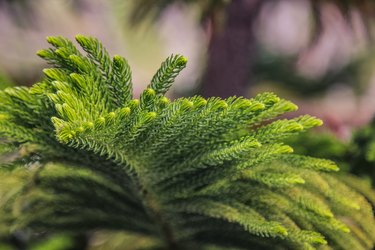
A Norfolk Island pine (Araucaria heterophylla) — also called a Norfolk pine — is a perky evergreen tree that can be planted outdoors in USDA zones 9 though 11 but must be overwintered indoors in colder climates. Exposure to cold temperatures is just one possible reason why your Norfolk Island pine's lower branches might be turning yellow or brown. Assess the tree's current growing conditions and make adjustments as needed to revive its growth and vitality.
Too Much Heat and Light
Video of the Day
Your Norfolk pine's leaves may be turning yellow or brown because it's struggling to cope with the current temperature. As their name implies, Norfolk Island pines are native to Norfolk Island in the South Pacific, where the weather averages between 55 and 77 degrees Fahrenheit year-round. The Norfolk pine thrives in these temperatures, but will become stressed or die in weather that's either too cold or too hot. In the United States, they are commonly grown as potted plants so they can be brought into an climate-controlled building when the outdoor temperatures drift out of the Norfolk pine's comfort zone.
Video of the Day
If your Norfolk pine has always stayed inside your heated and cooled home, its leaves might be burning due to too much direct sunlight. However, the leaves will also lose color if they don't receive enough sunlight each day. These trees prefer bright, filtered light with only two or three hours of direct morning light each day. An east-facing window provides the best option.
Improper Water and Humidity
Both overwatering and underwatering can stress a plant and cause its leaves to turn brown. Too much water can drown the plant and lead to nutrient deficiencies and rotten root issues, whereas too little water dehydrates the plant and causes leaves to die rapidly to conserve resources. Allow only the top inch of soil to become dry before watering deeply. A root-bound tree will also struggle to absorb sufficient water and should be planted in a larger pot.
Norfolk pines also prefer a humid environment. You can run a humidifier near the plant, regularly spritz its leaves with water or set up a humidity tray from which water evaporates as needed. Humidity trays can be placed next to or underneath the pot. It's crucial that the pot not actually touch the water in the tray, so make sure there are plenty of stones on the tray to prop it up out of the water.
Keep the tree away from HVAC vents in your home and away from exterior doors. The drafts of air — whether warm or cold — will dry out the plant. If you have no choice but to place the tree in a drafty location, pay extra attention to the humidity levels around the tree.
Some Browning Is Normal
To some degree, browning on the older, lower leaves of a Norfolk Island pine is normal. Typically, an entire branch doesn't turn brown unless the plant is stressed from one of the above circumstances. Trim off any branches that have turned totally brown, since they've died and won't regain their color. Individual browning needles peppered throughout healthy green needles will fall off on their own.